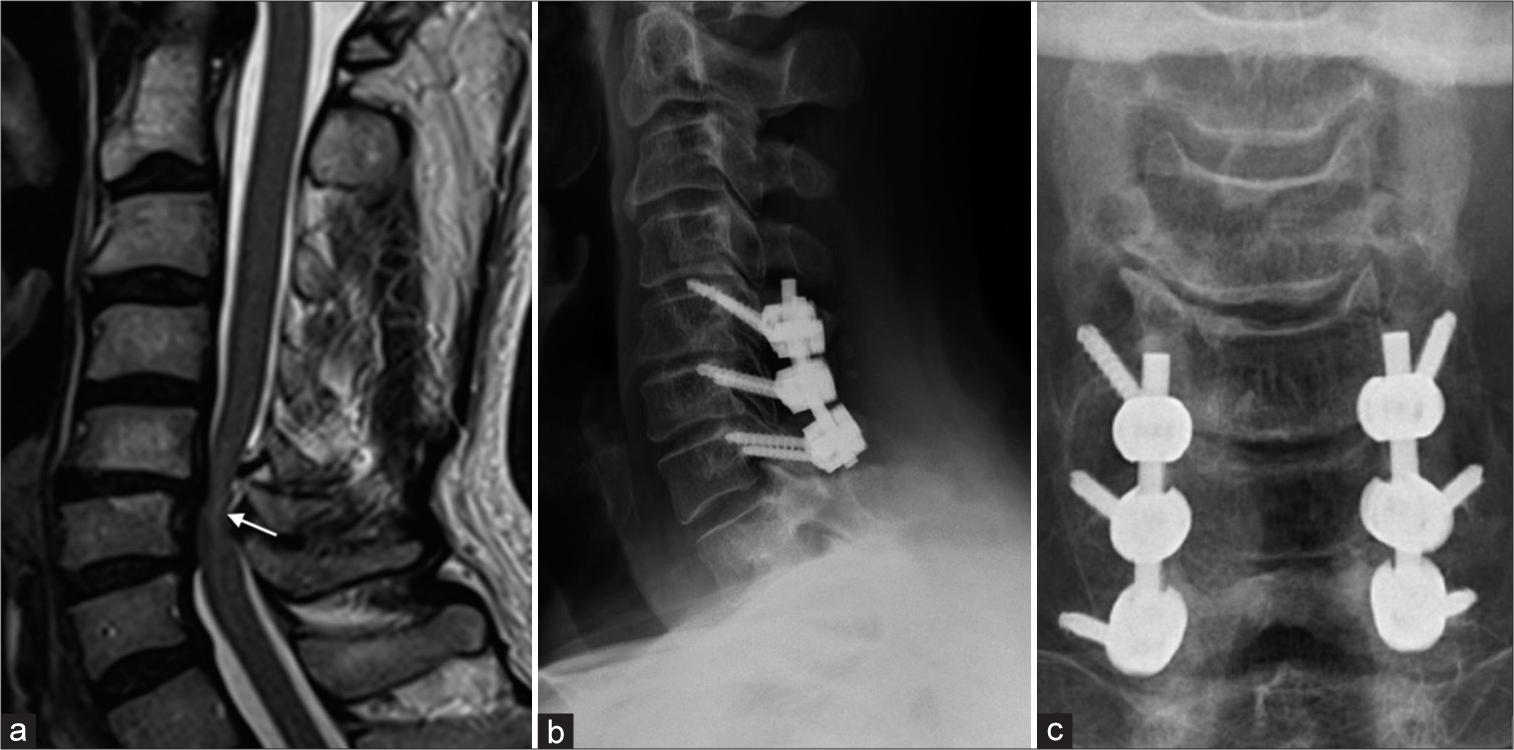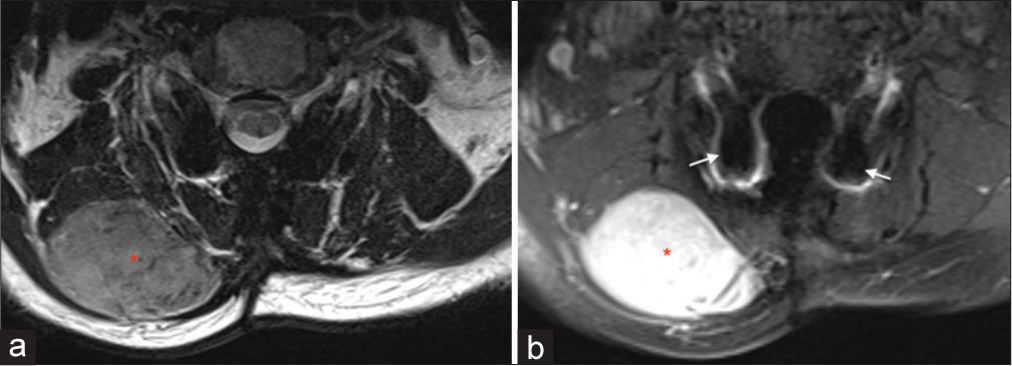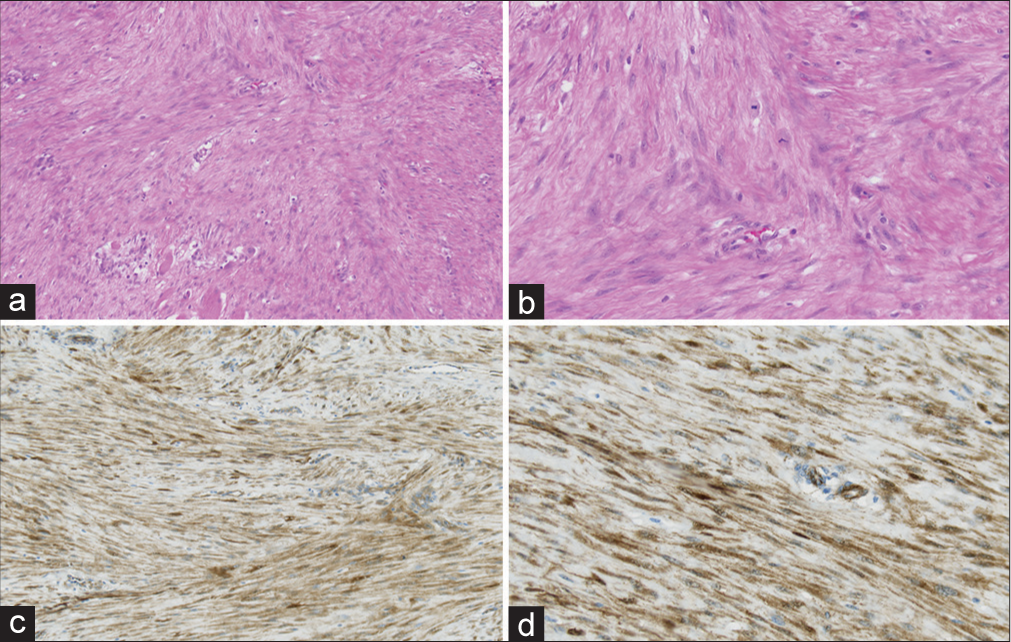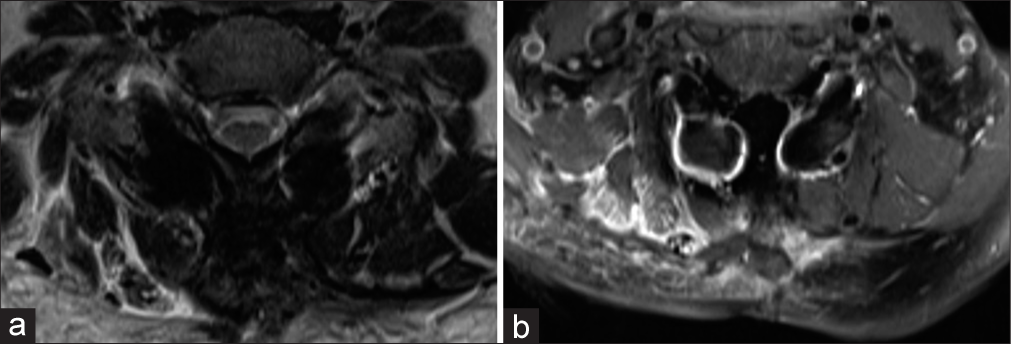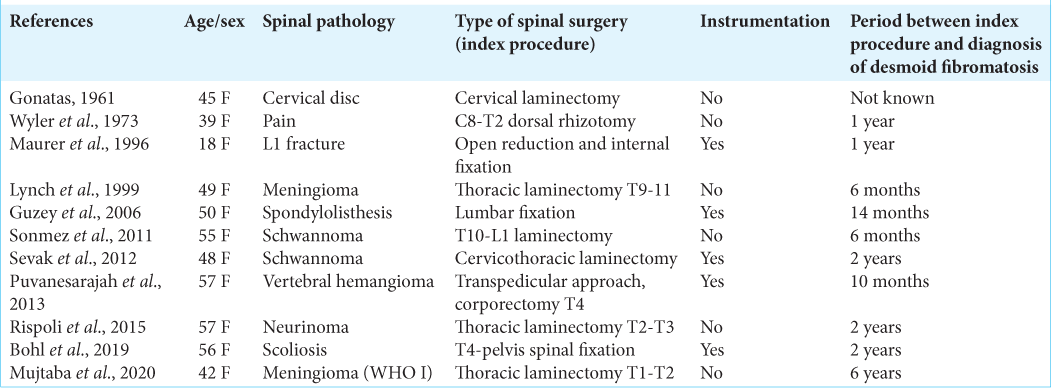- Centre for Spinal Surgery and Neurotraumatology, BG Unfallklinik Frankfurt am Main gGmbH, Germany.
Correspondence Address:
Holger Schlag, Centre for Spinal Surgery and Neurotraumatology, BG Unfallklinik Frankfurt am Main gGmbH, Germany.
DOI:10.25259/SNI_1240_2021
Copyright: © 2022 Surgical Neurology International This is an open-access article distributed under the terms of the Creative Commons Attribution-Non Commercial-Share Alike 4.0 License, which allows others to remix, transform, and build upon the work non-commercially, as long as the author is credited and the new creations are licensed under the identical terms.How to cite this article: Holger Schlag, Jonathan Neuhoff, Jens Castein, Chirstoph Hoffmann, Frank Kandziora. Sporadic desmoid fibromatosis of the neck after dorsal spondylodesis of the cervical spine. 18-Feb-2022;13:64
How to cite this URL: Holger Schlag, Jonathan Neuhoff, Jens Castein, Chirstoph Hoffmann, Frank Kandziora. Sporadic desmoid fibromatosis of the neck after dorsal spondylodesis of the cervical spine. 18-Feb-2022;13:64. Available from: https://surgicalneurologyint.com/surgicalint-articles/11394/
Abstract
Background: Rare soft-tissue tumors, termed desmoid fibromatosis (DF), are comprised proliferated spindle cell fibroblasts and myofibroblasts embedded in a prominent collagenous stroma. They can occur either sporadically, due to prior trauma or surgery, or may have a genetic component. Clinically, DF has a high infiltrative growth/ local recurrence rate, but does not metastasize.
Case Description: A 58-year-old male underwent a C5-C7 laminectomy/instrumented fusion. Two years later, he presented with a large gross swelling on the right side of the neck. The lesion was removed and proved to histologically consist of DF. Within the first postoperative 12 months, tumor did not recur.
Conclusion: Sporadic DF may follow trauma or prior surgery. Symptomatic tumors are treated by surgical en bloc resection (preferably R0). If lesions are inoperable, partially resected, or recur, different hormonal/ chemotherapeutic systematic treatment options are available (e.g., tamoxifen or tyrosine kinase inhibitors). In the future, better molecular understanding of DF likely offers additional therapeutic approaches (e.g., immune checkpoint inhibitors).
Keywords: Desmoid fibrosis, Soft-tissue tumor, Spine surgery
INTRODUCTION
Desmoid fibromatosis (DF) (also known as desmoid-type fibromatosis) is defined by the World Health Organization as a rare type of soft-tissue tumor that occurs with a frequency of 3–4 cases/ million per year. DF arises from fibroblasts/myofibroblasts of the muscle connective tissue, fascia, and aponeurosis and demonstrates infiltrative growth and a high local recurrence rate; however, they do not metastasize.[
CASE DESCRIPTION
A 58-year-old male underwent a C5-C7 laminectomy/rod-screw-instrumented fusion for multilevel spondylotic cervical myelopathy [
Figure 1:
A sagittal T2-weighted magnetic resonance imaging (a) of cervical spondylotic myelopathy patient shows the change of spinal cord signal intensity (white arrow). Postoperative cervical spinal X-ray showing lateral (b) and anteroposterior (c) view after decompressive cervical laminectomy and C4-6 lateral mass fusion.
Two years postoperatively, the patient newly presented with a progressive right-sided painful swelling of the posterolateral neck; the lesion was fixed to the skin/deep neck structures. The MR revealed a 5.2 × 4.5 × 3.7 cm mass; the lesion on the T1 study was iso-hypointense, on the T2-weighted image showed slight hyperintensity, and inhomogeneous enhancement with contrast [
Figure 2:
Axial T2-weighted (a) and contrast-enhanced axial T1-weighted (b) magnetic resonance imaging of the neck showing tumor mass (red asterix) anatomically located between the trapezius muscle and the splenius capitis muscle. Metal-related artifacts in MRI (b) caused by lateral mass screws (white arrow).
Surgery for DF
The patient underwent surgical en bloc resection of the mass that was located between the trapezius and splenius capitis muscles; it was well demarcated from the surrounding tissues. The 24 h postoperative MR confirmed complete tumor resection.
Histology and Immunohistochemistry of DF
Histologically, the DF showed spindle cell fibroblast proliferation embedded in a collagenous stroma with rim infiltration of the skeletal muscle. Immunohistochemistry showed a cytoplasmic and nuclear expression of β-catenin [
Figure 3:
(a) Histopathologic specimen demonstrating spindle cell fibroblast proliferates embedded in a collagenous stroma network with rim infiltration of skeletal muscle (H&E, ×10) and (b) nonatypical mitotic figures in desmoid fibromatosis (H&E, ×20). (c) (×10) and (d) (×20): cytoplasmic and nuclear expression of β-catenin, which is typical for desmoid fibromatosis.
Twelve-month postoperative course
At 6 months and 12 postoperative months, the patient was clinically asymptomatic. Further, the 12-month postoperative magnetic resonance imaging (MRI) showed no tumor recurrence [
DISCUSSION
The occurrence of DF after spinal surgery has been reported sporadically and typically ranges from 10 months to 7 postoperative years[
CONCLUSION
Here, we presented a 58-year-old male who, 2 years following a C5-C7 laminectomy/fusion, presented with a right posterolateral neck mass that was diagnosed as a DF. Following gross total en bloc excision, the lesion did not recur within 12 postoperative months.
Declaration of patient consent
Patient’s consent not required as patients identity is not disclosed or compromised.
Financial support and sponsorship
Nil.
Conflicts of interest
There are no conflicts of interest.
References
1. Bauer BM, Williams NL, Zuckerman LM. Development of multifocal extra-abdominal desmoid fibromatosis after surgical resection. Clin Case Rep. 2019. 7: 2515-9
2. Bohl MA, Leveque JC, Bayles S, Sethi R. Postoperative development of desmoid tumor after surgical correction of adult spinal deformity: Case report and review of literature. World Neurosurg. 2019. 128: 4-10
3. Desmoid Tumor Working G. The management of desmoid tumours: A joint global consensus-based guideline approach for adult and paediatric patients. Eur J Cancer. 2020. 127: 96-107
4. Dinauer PA, Brixey CJ, Moncur JT, Fanburg-Smith JC, Murphey MD. Pathologic and MR imaging features of benign fibrous soft-tissue tumors in adults. Radiographics. 2007. 27: 173-87
5. Gonatas NK. Extra-abdominal desmoid tumors. Report of six cases. Arch Pathol. 1961. 71: 214-21
6. Guzey FK, Emel E, Bas NS, Ozkan N, Turgut H, Sel B. Aggressive postoperative lumbar fibromatosis after the placement of instrumentation for treatment of spondylolisthesis. Case report. J Neurosurg Spine. 2006. 4: 338-41
7. Kasper B, Baumgarten C, Bonvalot S, Haas R, Haller F, Hohenberger P. Management of sporadic desmoid-type fibromatosis: A European consensus approach based on patients’ and professionals’ expertise-a sarcoma patients EuroNet and European organisation for research and treatment of cancer/soft tissue and bone sarcoma group initiative. Eur J Cancer. 2015. 51: 127-36
8. Keus RB, Nout RA, Blay JY, de Jong JM, Hennig I, Saran F. Results of a phase II pilot study of moderate dose radiotherapy for inoperable desmoid-type fibromatosis-an EORTC STBSG and ROG study (EORTC 62991-22998). Ann Oncol. 2013. 24: 2672-6
9. Lynch JJ, Parvizi J, Scheithauer BW, Krauss WE. Development of postoperative fibromatosis after resection of an intraspinal meningioma. Case report. J Neurosurg. 1999. 90: 121-4
10. Maurer F, Horst F, Pfannenberg C, Wehrmann M. Multifocal extra-abdominal desmoid tumor-diagnostic and therapeutic problems. Arch Orthop Trauma Surg. 1996. 115: 359-62
11. Mujtaba B, Call C, Rowland F, Spear RP, Amini B, Valenzuela R. Desmoid fibromatosis following surgical resection of spinal meningioma. Radiol Case Rep. 2020. 15: 697-701
12. Puvanesarajah V, Lina IA, Liauw JA, Hsu W, Burger PC, Witham TF. Desmoid tumor formation following posterior spinal instrumentation placement. Evid Based Spine Care J. 2013. 4: 137-42
13. Rispoli R, di Chirico A, Tinella E, Peciarolo A, Ascani S, Caputo N. Desmoid tumor following dorsal laminectomy: Case report. Clin Case Rep Rev. 2016. 1: 251-2
14. Sevak S, Blount AL, Cottingham S, DeLano M, Woude DL, Stevenson J. Fibromatosis of the cervical region following laminectomy: A case report and literature review. Spine (Phila Pa 1976). 2012. 37: E456-9
15. Sonmez E, Altinors N, Gulsen S, Ozen O. Extraabdominal desmoid tumor appearing following resection of thoracolumbar schwannoma. Turk Neurosurg. 2011. 21: 246-8
16. Wyler AR, Harris AB. Recurrent desmoid tumor following cervical laminectomy. Case report. J Neurosurg. 1973. 39: 114-6


